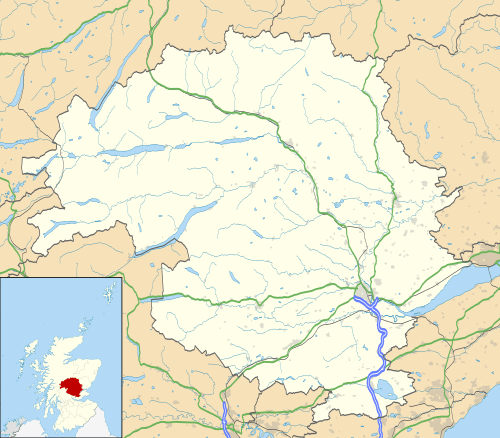Huntingtower and Ruthvenfield
| Huntingtower and Ruthvenfield | |
|---|---|
 Huntingtower and Ruthvenfield Huntingtower and Ruthvenfield shown within Perth and Kinross | |
| OS grid reference | NO074249 |
| Council area | |
| Lieutenancy area | |
| Country | Scotland |
| Sovereign state | United Kingdom |
| Post town | PERTH |
| Postcode district | PH1 |
| Dialling code | 01738 |
| Police | Scottish |
| Fire | Scottish |
| Ambulance | Scottish |
| EU Parliament | Scotland |
| UK Parliament | |
| Scottish Parliament | |

Huntingtower and Ruthvenfield, a village of Perthshire, Scotland, on the River Almond, some ten miles north-west of Perth.
Bleaching, the chief industry, dated from 1774, when the bleaching-field was formed. By means of an old aqueduct, said to have been built by the Romans, it was provided with water from the River Almond, the properties of which rendered it especially suited for bleaching. Bleaching (by chemicals under cover, not with bleach fields) continued Huntingtower until 1981.
Huntingtower (originally Ruthven) Castle, a once formidable structure, was the scene of the Raid of Ruthven (pron. Rivven), when the Protestant lords, headed by William, 4th Lord Ruthven and 1st Earl of Gowrie (1441–1584), kidnapped the boy-king James VI, on August 22, 1582. The earl's sons were slain in the attempt (known as the Gowrie conspiracy) to capture James VI (1600), consequent on which the Scots parliament ordered the name of Ruthven to be abolished, and the barony to be known in future as Huntingtower.
Notable persons
George Turnbull was brought up in Huntingtower. He was the Chief Engineer building the first major Indian railway in the 1850s.[1][2]
References
- ↑ Diaries of George Turnbull (Chief Engineer, East Indian Railway Company) held at the Centre of South Asian Studies at Cambridge University, England
- ↑ George Turnbull, C.E. 437-page memoirs published privately 1893, scanned copy held in the British Library, London on compact disk since 2007
![]()
| Wikimedia Commons has media related to Huntingtower and Ruthvenfield. |